| |
|
Xiamen Oil Paintings, Wholesale Direct!
|
|
100% hand painted, 100% cotton canvas, 100% money back if not satisfaction. |
|
|
|
|
ART WORKS INDEX
A
B
C
D
E
F
G
H
I
J
K
L
M
N
O
P
Q
R
S
T
U
V
W
X
Y
Z
|
|
ARTISTS INDEX
A
B
C
D
E
F
G
H
I
J
K
L
M
N
O
P
Q
R
S
T
U
V
W
X
Y
Z
|
|
|
|
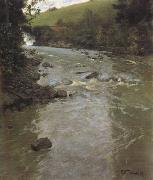 |
Frits Thaulow
|
|
Norwegian Impressionist Painter, 1847-1906
.Norwegian painter and engraver. Originally wanting to become a marine painter he studied at the art academy in Copenhagen (1870-73) as well as with the Danish marine specialist C. F. S?rensen (1818-79). He spent two winters at Karlsruhe (1873-4, 1874-5) as the pupil of Hans Gude and then went to Paris, where he spent much of the period 1875-9. His marines and coastal pictures, some of which were accepted at the Paris Salon, were only moderately successful, but he acquired a fair knowledge of contemporary French Realist art and felt that Norwegian artists should learn from it.
|
|
|
|
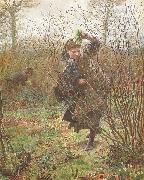 |
Frederick Walker,ARA,RWS
|
|
1840-1875
English painter and illustrator. He acquired his training in drawing and painting through study in the British Museum (where he copied heavily from the Antique), a short period spent in an architect's office, life classes at Leigh's school, a studentship at the Royal Academy and three years' employment as a draughtsman on wood with the commercial engraver Josiah Wood Whymper (1813-1903).
|
|
|
|
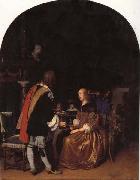 |
Frans van mieris the elder
|
|
Dutch Baroque Era Painter, 1635-1681
was a Dutch genre and portrait painter. The leading member of a Leiden family of painters, his sons Jan (1660-1690) and Willem (1662 C1747) and his grandson Frans van Mieris the Younger (1689 C1763) were also accomplished genre painters. Frans was the son of Jan Bastiaans van Mieris, a goldsmith, carver of rubies and diamond setter at Leiden. His father wished to train him to his own business, but Frans preferred drawing, and took service with Abraham Torenvliet, a glazier who kept a school of design. In his father's shop he became familiar with the ways and dress of people of distinction. His eye was fascinated in turn by the sheen of jewelry and stained glass; and, though he soon gave up the teaching of Torenvliet for that of Gerard Dou and Abraham van den Tempel, he acquired a manner which had more of the finish of the exquisites of the Dutch school than of the breadth of the disciples of Rembrandt. It should be borne in mind that he seldom chose panels of which the size exceeded 12 to 15 inches, and whenever his name is attached to a picture above that size we may surely assign it to his son Willem or to some other imitator. Unlike Dou when he first left Rembrandt, or Jan Steen when he started on an independent career, Mieris never ventured to design figures as large as life. Characteristic of his art in its minute proportions is a shiny brightness and metallic polish. The Music Lesson,National Museum of Serbia , BelgradeThe subjects which he treated best are those in which he illustrated the habits or actions of the wealthier classes; but he sometimes succeeded in homely incidents and in portrait, and not unfrequently he ventured on allegory. He repeatedly painted the satin skirt which Ter Borch brought into fashion, and he often rivalled Ter Borch in the faithful rendering of rich and highly-coloured woven tissues. But he remained below Ter Borch and Metsu, because he had not their delicate perception of harmony or their charming mellowness of touch and tint, and he fell behind Gerard Dou, because he was hard and had not his feeling for effect by concentrated light and shade. In the form of his composition, which sometimes represents the framework of a window enlivened with greenery, and adorned with bas-reliefs within which figures are seen to the waist, his model is certainly Dou.
|
|
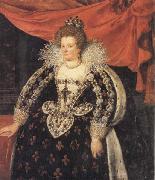 |
Frans Pourbus the younger
|
|
Flemish Baroque Era Painter, 1569-1622
was a Flemish painter, son of Frans Pourbus the Elder and grandson of Pieter Pourbus. He was born in Antwerp and died in Paris. He is also referred to as "Frans II". Pourbus worked for many of the highly influential people of his day, including the Brussels-based Spanish Regents of the Netherlands, the Duke of Mantua and Marie de' Medici, Queen of France. Works of his can be found in the Louvre, the Prado, the Rijksmuseum, the Royal College of Art, the Metropolitan Museum of Art and many other museums.
|
|
|
|
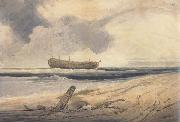 |
Francois Louis Thomas Francia
|
|
French, 1772-1839
was a French painter born in Calais and famous for his shore landscapes. He was the master of the young British painter Richard Parkes Bonington. This article about a French painter is a stub.
|
|
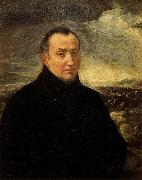 |
Francois de Troy
|
|
French Baroque Era Painter, 1645-1730
was a French painter and engraver who became principal painter to King James II in exile at Saint-Germain-en-Laye and Director of the Academie Royale de peinture et de sculpture. One of a family of artists, Troy was born in Toulouse, the son of Nicolas de Troy (1608 - 15 September 1684), a painter in that city,and was the brother of Jean de Troy (4 April 1638 - 25 June 1691).Troy was taught the basic skills of painting by his father, and perhaps also by the more worldly Antoine Durand. François de Troy is not to be confused with his son, the portrait painter Jean-François de Troy (1679-1752), who studied under him At some time after 1662, Troy went to Paris to study portrait painting under Claude Lefebvre (1633-1675) and Nicolas-Pierre Loir (1624 - C1679]. A. P. F. Robert-Dumesnil states that this occurred when Troy was aged twenty-four. In 1669, Troy married his master Nicolas-Pierre Loir's sister-in-law, Jeanne Cotelle. In 1671, he was approved by the Academie Royale de peinture et de sculpture. In 1674, he was received into the Academy as a history painter, with a reception piece (morceau de reception) entitled Mercure coupant la tete d'Argus ('Mercury cutting off the head of Argus'). Troy's early known works include tapestry designs for Madame de Montespan, one of the many mistresses of Louis XIV of France, and paintings with religious and mythological subjects. In the 1670s, he became friendly with Roger de Piles, who introduced him to Dutch and Flemish painting,
|
|
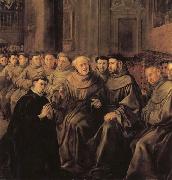 |
Francisco de herrera the elder
|
|
Spanish Baroque Era Painter, ca.1590-1656
Spanish painter. His early works are in the Mannerist style. Under the influence of Francisco Zurbaren, he developed the naturalistic style seen in his four scenes from the life of St. Bonaventure (1627). About 1650 he moved to Madrid. His last documented work, a painting of St. Joseph (1648) influenced by Anthony Van Dyck, features elongated forms and elaborate draperies. He achieved considerable fame in Sevilla, where Diego Velezquez was briefly his pupil. His work marked the transition from Mannerism to the Baroque. His son, Francisco Herrera the Younger
|
|
 |
Francis Towne
|
|
English Painter, 1739-1816
was an English water-colour painter. He was born in Isleworth, Middlesex, the son of a corn chandler. Apprenticed to a coach painter in London, he won a design prize from the Society of Arts, and studied for a while at St Martin??s Lane Academy. In 1763 he was employed by a coach painter called Thomas Watson, and went to Exeter on business. He had already begun painting in oils and also taught drawing, and now he began to accept commissions from wealthy families in Devon. After a tour of north Wales in 1777, undertaken with his friend, the lawyer John White, he began to specialize in water-colours. In 1780 he travelled to Rome and from there to Naples. On his return to Devon, he was asked by Sir Thomas and Lady Acland of Killerton to paint some views in Devon and North Wales, and in 1786 he went on a painting tour of the Lake District
|
|
 |
Francesco Trevisani
|
|
Italian Rococo Era Painter , Capodistria 1656-1746 Rome
was an Italian painter, active in the period called either early Rococo or late Baroque (barochetto) Born in Capodistria (modern Koper, then part of the Republic of Venice), he was the son of Antonio Trevisani, an architect, by whom he was instructed in the first rudiments of design. He then studied in Venice under Antonio Zanchi. He moved to Rome, where he remained until his death, in 1678. His brother, Angelo Trevisani remained a prominent painter in Venice. In Rome, he was supported by Cardinal Pietro Ottoboni. He was strongly influenced by Carlo Maratta, as it is manifest in his masterpiece, the frescoes in San Silvestro in Capite (1695-1696). In this commission, he worked alongside Giuseppe Chiari and Ludovico Gimignani. In Rome, he was favored with the patronage of Cardinal Chigi. Chigi employed him in several considerable works, and recommended him to the protection of Pope Clement XI, who not only commissioned him to paint one of the Prophets in San Giovanni Laterano, but engaged him to decorate the cupola of the cathedral in Urbino. There he represented, in fresco, allegories of the four Quarters of the World, in which he displayed much invention and ingenuity. He was employed by the Duke of Modena, in copying the works of Correggio, Parmigianino, and also painted in Brunswick, Madrid, Munich, Stockholm, and Vienna. He also shows Maratta's influence in the cartoons for baptismal chapel in St. Peter's Basilica, in the oval with Prophet Baruch in San Giovanni in Laterano, and in the Death of St. Joseph in Sant'Ignazio. Trevisani painted scenes from the Life of the Blessed Lucy of Narni in the church of Narni (1714-15).
|
|
|
|
|
|
|
|
|
|
 |
Ettore Tito
|
|
(17 December 1859-26 June 1941) was an Italian artist particularly known for his paintings of contemporary life and landscapes in Venice and the surrounding region. He trained at the Accademia di Belle Arti in Venice and from 1894 to 1927 was the Professor of Painting there. Tito exhibited widely and was awarded the Grand Prize in painting at the 1915 Panama CPacific International Exposition in San Francisco. In 1926 he was made a member of the Royal Academy of Italy. Tito was born in Castellammare di Stabia in the province of Naples and died in Venice, the city which was his home for most of his life.
|
|
|
|
 |
Edward Troye
|
|
American Artist .
b.1808 d.1874
American painter of Swiss birth. Before 1822, his father, Jean-Baptiste de Troy, a sculptor of minor fame, moved his family to England, where Edward was instructed in drawing and perhaps painting. The animal painter Jacques-Laurent Agasse knew the family well. Troye wrote in 1857 that he was trained in London by the best masters and stated that he followed the style of George Stubbs and John N. Sartorius. In 1831 Troye arrived in Philadelphia, where he was employed as a magazine illustrator. The following year he exhibited animal subjects at the annual Pennsylvania Academy of Fine Arts exhibition and rapidly found patrons among racehorse owners. His typical works show motionless, unsaddled and riderless animals against a low horizon
|
|
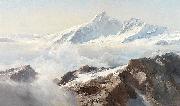 |
Edward Theodore Compton
|
|
(July 29 1849 - March 22 1921) was an English-born, German artist, illustrator and mountain climber. He is well-known for his paintings and drawings of alpine scenery, and as a mountaineer made 300 major ascents including no fewer than 27 first ascents.
Compton was born in Stoke Newington in London, the son of Theodore Compton, an art-loving insurance agent, and grew up in a deeply religious Quaker household. He attended various art schools, including, for a time, the Royal Academy in London, but otherwise he was mainly self-taught in art.
|
|
 |
edward r taylor
|
|
Edward Richard Taylor RBSA (June 14, 1838 - January 11, 1911) was an English artist and educator. He painted in both oils and watercolours.
Taylor taught at the Lincoln School of Art and became influential in the Arts and Crafts movement as the first headmaster at the Birmingham Municipal School of Arts and Crafts from 1877-1903.
In December 1898, he founded Ruskin Pottery at Smethwick, Staffordshire. His son William Howson Taylor (1876 -1935) took over Ruskin Pottery after the death of his father.
|
|
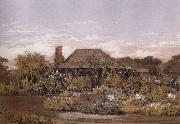 |
Edward La Trobe Bateman
|
|
book illuminator, draughtsman, architectural decorator and garden designer.
English
c.1815-1897
was a pre-raphaelite landscape artist, book illuminator and draughtsman. He was probably born in Derbyshire. Edward had lived in London where he had been engaged to the daughter of William and Mary Howitt. Edward visited Australia and stayed initially with Godfrey Howitt. In 1856, the Carlton Gardens in Melbourne were redesigned and Edward la Trobe Bateman was engaged to do the designs.
|
|
 |
Edmund Tull
|
|
(1870 - 1911) was a Hungarian artist born at Szekesfeherver. He was educated at Budapest, Milan, and Paris, being in the last-named city a pupil of J. P. Laurens and of B. Constant. His first work, "The Cathedral of Notre Dame," attracted attention at the exposition in Budapest in 1896, while his etchings are especially valued in London and Vienna. His best-known works are: "Peasant Mowing," "A Lane in Dort," and "The Island of Capri," in the historical art museum of Budapest; and "The Smithy," owned by Archduchess Isabella.
|
|
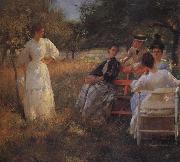 |
Edmund Charles Tarbell
|
|
American Impressionist Painter, 1862-1938
American painter, illustrator and teacher. He attended drawing lessons at the Normal Art School, Boston, MA, and art classes with W. A. G. Claus. From 1877 to 1880 he was apprenticed to a lithographic company in Boston. In 1879 Tarbell entered the School of the Boston Museum of Fine Arts, where he was a pupil of Otto Grundmann (1844-90), a former student of Baron Hendrik Leys in Antwerp. In 1883 Tarbell left for Paris with his fellow student Frank W. Benson. Both Tarbell and Benson attended the Acad?mie Julian, where they studied with Gustave Boulanger and Jules Lefebvre. They travelled to Italy in 1884 and to Italy, Belgium, Germany and Brittany the following year. Tarbell returned to Boston in 1886. Initially after his return, Tarbell made a living from magazine illustration, teaching privately and painting portraits. In 1889 Tarbell and Benson took Grundmann's place at the Museum School.
|
|
|
|
 |
Dwight William Tryon
|
|
(August 13, 1849 ?C July 1, 1925) was an American landscape painter in the late 19th and early 20th centuries. His work was influenced by James McNeill Whistler, and he is best-known for his landscapes and seascapes painted in a tonalist style.
Tryon was born in Hartford, Connecticut. His father was killed in a gun accident before Tryon reached four years of age, and Tryon was raised by his mother on his grandparent's farm in East Hartford. His interest in art evolved naturally. As a young man Tryon took a job at a prominent Hartford bookstore and studied art instruction manuals from the store shelves. He also took to sketching the surrounding countryside during his off hours
Tryon sold his first painting in 1870. After exhibiting and selling work locally, he successfully exhibited at the National Academy of Design in 1873. His artistic convictions affirmed, Tryon married, quit his job at the bookstore and became a full-time artist. Some of his first works from this period are seascapes and harbor views executed in a luminist manner. Soon after, however, Tryon's style shifted towards the Barbizon school, which was then becoming popular among American artists. He may have been influenced by the works of George Inness and Alexander Helwig Wyant.
In 1876 Tryon decided to advance his skills through a formal study of art. He sold all of his paintings at auction and, with the help of a benefactor, traveled to France with his wife. He enrolled in the atelier of Jacquesson de la Chevreuse, and took classes at the École des Beaux-Arts. He also received instruction from Charles-François Daubigny, Henri Harpignies, and Jean Baptiste-Antoine Guillemet. Impressionism was blossoming in France all around Tryon, but he was not swayed by the new style and remained comfortably within the realm of the Barbizon school.
Tryon traveled and sketched Europe with his wife, and met Abbott Handerson Thayer and his wife with whom he became friends. He returned to the United States in 1881 and settled in New York City where he taught and painted landscapes. In New York, Tryon became friends with artists Robert Swain Gifford and Thomas Dewing. He became an early member of the Society of American Artists and continued to exhibit paintings to the National Academy of Design. He also became a member of the American Water Color Society and the National Institute of Arts and Letters (now The American Academy of Arts and Letters).
On the advice of Gifford, Tryon and his wife built a summer house in South Dartmouth, Massachusetts in 1887. Though he would continue to spend each winter in New York City, South Dartmouth became Tryon's home for the rest of his life. The coastal area appealed to Tryon's aesthetic sensibilities and allowed him to indulge in fishing, his favorite pastime.
By the late 1880s Tryon began painting landscapes in what would become his mature and iconic style. Working most often in oil, Tryon's paintings typically feature a group or broken row of trees in the middle distance, often colored in an autumnal hue, separating a glowing sky above and a foreground marsh or pasture below. He also continued to paint the sea in his mature career, often employing pastel to show a bare expanse of water, sky and beach in various weather and light. He exhibited his works nationally but tended to favor The Pennsylvania Academy of Fine Arts in Philadelphia and the Montross Gallery in New York.
A Detroit industrialist, Charles Lang Freer, first bought a painting by Tryon in 1889 and became Tryon's most important patron. Freer eventually bought dozens of Tryon's paintings, including many of his best works, and worked closely with Tryon in the interior design of his Detroit home. Freer, a major collector of Asian art and works by James McNeill Whistler, went on to establish the Freer Gallery of Art, part of the Smithsonian Institution in Washington, DC, where many works by Tryon can be seen today.
Took the coveted First Prize for his painting Salt-Marsh, December at the Tennessee Centennial Exposition that was held in Nashville, Tennessee in 1897. He is described in the "Fine Art Catalogue" which is copyrighted by Theodore Cooley as follows: William Tryon is an American landscape painter whose pictures are greatly sought for their delicacy of coloring and refinement of feeling. A pupil of Daubdigny, he is, like that artist, a painter of country life - the idyllic rusticity of apple trees in bloom, of waving cornfields, of shining valleys and streams rippling gently to the sea. He is especially fine in the silvery-gray atmosphere.
In addition to his painting, Tryon taught at Smith College from 1886 to 1923, visiting part time to critique students' work and, late in his career, establishing the Tryon Gallery of Art. He died of cancer in South Dartmouth on July 1, 1925.
|
|
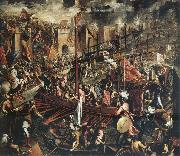 |
Domenico Tintoretto
|
|
Italian, 1560-1635,Son of Jacopo Tintoretto. He was taught by his father and assisted him in his workshop. At the age of 17 he was admitted to the Venetian painters' guild, and he is recorded in the confraternity of painters from 1594. He began his career by helping his father to execute the paintings in the Sala del Collegio and Sala del Senato in the Doge's Palace, Venice. Following this he worked independently at the palace, on the Sala dello Scrutinio and the Sala del Maggiore Consiglio. His training with his father helped him in his own compositions, several of which, such as the Battle of Salvore, or the Second Conquest of Constantinople, are heroic battle themes with complex groupings and dramatic poses. In the last two decades of the 16th century Domenico concentrated on religious commissions in Venice, including a Last Supper and Crucifixion (both c. 1583) for S Andrea della Zirada (both in situ), a Marriage of the Virgin for S Giorgio Maggiore (in situ) and a Crucifixion for the Scuola dei Mercanti.
|
|
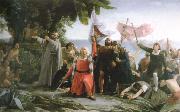 |
dioscoro teofilo puebla tolin
|
|
dioscoro teofilo puebla tolin(1831 to1901),who studied in madrid and rome,worked in the tradition fo historicism,asubgenre of history painting,which focused on the interplay of religious pride,patriotism ,and sntions of glory.tolin s technical style is referred to as eclecticism for its wide ranging,and often superficial ,borrowing from euopean techniques and visual trends. paintings in this genre were often funded by official organizations and art academies,which treated them as opportuities for propagandistic interpretations of history.the first landing of christopher columbus in america provides on shortage of drama
|
|
|
|
dioscoro teofilo de la puebla tolin
|
|
dioscoro teofilo de la puebla tolin(1831 to1901),who studied in madrid and rome,worked in the tradition fo historicism,asubgenre of history painting,which focused on the interplay of religious pride,patriotism ,and sntions of glory.tolin s technical style is referred to as eclecticism for its wide ranging,and often superficial ,borrowing from euopean techniques and visual trends. paintings in this genre were often funded by official organizations and art academies,which treated them as opportuities for propagandistic interpretations of history.the first landing of christopher columbus in america provides on shortage of drama
|
|
 |
Diego Quispe Tito
|
|
(1611-1681) was a Peruvian painter. He is considered the leader of the Cuzco School of painting.
The son of a noble Inca family, Quispe Tito was born in Cuzco, and worked throughout his life in the district of San Sebastien; his house is still extant, and shows his coat of arms on its door. His earliest signed painting is an Immaculate Conception from 1627, gilded in a fashion typical of the Cuzco school. The work's elongated forms reveal a knowledge of Mannerism; where Quispe Tito learned the style is unknown, but it is hypothesized that he encountered it in the work of Italian Jesuit Bernardo Bitti, who was active at the time in Cuzco. In addition, he is believed to have known Luis de Riaño in his youth, and may have derived some elements of his style from the older artist; de Riaño, a painter from Lima, had trained in the workshop of Angelino Medoro, and so would have provided another source of Italian influence.
Quispe Tito also was influenced in his work by engravings from Flanders; indeed, his best-known work, the 1681 Signs of the Zodiac in Cuzco Cathedral, is a series of copies of Flemish engravings in which each zodiac sign is tied to a parable from the life of Christ. These engravings were designed for distribution in Peru, where worship of the sun, moon, and stars was still practiced in some quarters; they were designed to encourage worship of Christ and His miracles in place of the zodiac. A further series, depicting scenes from the life of John the Baptist and dating to 1663, was also produced on Flemish models.
|
|
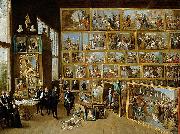 |
David Teniers the Younger
|
|
(December 15, 1610 C April 25, 1690), a Flemish artist born in Antwerp, was the more celebrated son of David Teniers the Elder, almost ranking in celebrity with Rubens and Van Dyck. His son David Teniers III and his grandson David Teniers IV were also painters. His wife Anna nee, Anna Breughel was the daughter of Jan Brueghel the Elder and the granddaughter of Pieter Bruegel the Elder.
Through his father, he was indirectly influenced by Elsheimer and by Rubens. The influence of Adriaen Brouwer can be traced to the outset of his career. There is no evidence, however, that either Rubens or Brouwer interfered in any way with Teniers's education, and Smith (Catalogue Raisonne) may be correct in supposing that the admiration which Brouwer's pictures at one time excited alone suggested to the younger artist his imitation of them. The only trace of personal relations having existed between Teniers and Rubens is the fact that the ward of the latter, Anne Breughel, the daughter of Jan (Velvet) Breughel, married Teniers in 1637.
|
|
 |
David Teniers
|
|
Belgian
1610-1690
David Teniers Gallery
Flemish painter. His father, also named David Teniers (1582 ?C 1649), was a painter of primarily religious subjects. The younger Teniers was highly prolific and is best known for his genre scenes of peasant life, many of which were used for tapestry designs in the 18th century. He was brilliant at handling crowd scenes in an open landscape and adept at characterizing his figures with a warm, human, and often humorous touch. As court painter to the archduke Leopold William, he also made many small-scale copies of paintings in the archduke collection; engraved and published as Theatrum Pictorium (1660), they constitute a valuable source as a pictorial inventory of a great 17th-century collection.
|
|
|
|
 |
Cosme Tura
|
|
Italian Early Renaissance Painter, ca.1430-1495
Italian Renaissance artist. He was a leading master of the school of Ferrara and court painter to the city's ruling Este family. Often vividly emotional, Tura's figures range from the graceful to the grotesque, as in the gentle Mary and contorted Jesus of his c.1472 Pieta (Correr Museum, Venice). Combining material splendor with asceticism, his stylistically idiosyncratic paintings are frequently filled with sharply portrayed natural details??diversified landscapes, squirrels, monkeys, fruits, etc.??that serve as both plastic and iconographic elements. His works are executed in a harsh, nervously linear, and rather angular style, with bold and sometimes strident coloring. Examples of his art include two organ panels, Annunciation and St. George Slaying the Dragon (cathedral, Ferrara); Christ on the Cross (Milan); St. Jerome (National Gall., London); Portrait of a Man and Saints (National Gall. of Art, Washington, D.C.). Attributed to him is a portrait of a member of the Este family, The Flight into Egypt, and St. Louis of Toulouse
|
|
 |
Cosimo Tura
|
|
1430-95
Italian Cosimo Tura Galleries
Cosimo Tura (c. 1430 ?C 1495), also known as Il Cosm?? or Cosme Tura, was an Italian early-Renaissance (or Quattrocento) painter and considered one of the founders of the School of Ferrara.
Born in Ferrara, he was a student of Francesco Squarcione of Padua. Later he obtained patronage from both Dukes Borso and Ercole I d'Este. By 1460, he was stipended by the Ferrarese Court. His pupils include Francesco del Cossa and Francesco Bianchi. He appears influenced by Mantegna's and Piero della Francesca's quattrocento styles.
In Ferrara, he is well represented by frescoes in the Palazzo Schifanoia (1469?C71) . This pleasure palace, with facade and architecture of little note, belonged to the d'Este family and is located just outside the medieval town walls. Cosimo, along with Francesco del Cossa, helped produce an intricately conceived allegorical series about the months of the year and zodiac symbols. The series contains contemporary portraits of musicians, laborers, and carnival floats in idyllic parades. As in Piero della Francesca's world, the unemotive figures mill in classical serenity.
He also painted the organ doors for the Duomo showing the Annunciation (1469). He collaborated in the painting of a series of "muses" for a studiolo of Leonello d'Este, including the allegorical figure of Calliope at the National Gallery (see image). While the individual attributions are often debated, among the artists thought to complete the Angelo di Pietro da Sienna, also called Maccagino or Angelo Parrasio, and Michele Pannonio.
|
|
 |
constant troyon
|
|
French Barbizon School Painter, 1810-1865 Troyon's students included Evariste-Vital Luminais. French painter. He was brought up among the Sevres ceramics workers and received his first lessons in drawing and painting from Denis-Desire Riocreux (1791-1872), a porcelain painter who was one of the founders of the Musee National de Ceramique. Troyon began his career as a painter at the Sevres factory while also studying landscape painting in his spare time.
|
|
|
|
|
|
|
|
|
|
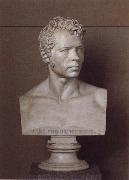 |
Christian Friedrich Tieck
|
|
1776-1851 Berlin,was a German sculptor and a brother of Ludwig Tieck. Tieck was born in Berlin, where he also died. He was taught by Johann Gottfried Schadow. Based on a concept by Karl Friedrich Schinkel, Tieck created the tomb of General Gerhard von Scharnhorst at Berlin's Invalidenfriedhof in 1822. He also created a bust of Wilhelm Heinrich Wackenroder and a lion made of bronze after a model by Christian Daniel Rauch.
|
|
|
|
|
|
|
|
|
|
 |
Carl Tragardh
|
|
(20 September 1861 - 5 June 1899) was a Swedish painter.
Trägårdh studied at the Royal Swedish Academy of Arts in Stockholm 1881-1883, in Karlsruhe 1883-84, and Munich until 1885. He then moved to France where he became a resident until his death. He exhibited both in Sweden and in France. He received a couple of medals and found a patron in the French singer and art collector Jean-Baptiste Faure (1830 - 1914) who bought some 40 paintings by him. His production is often landscape with grazing cattle, usually cows or sheep.
|
|
|
|
 |
Bill Traylor
|
|
African-American Folk Artist, ca.1856-1949
was a self-taught artist born an Alabama slave. Unable to read or write, he first began drawing in 1939 at the age of eighty-three. He worked full-time for the next four years to produce over eighteen hundred drawings. He used a straight edge to create geometric silhouettes of human and animal figures which he then filled in with crayon and tempera. He is known for his intriguing use of pattern versus flat color and a remarkably intuitive sense of space. He started hanging his works on a nearby fence to entertain the locals. One of his first fans was Charles Shannon, a painter who introduced Traylor to the New South regionalist artists and organized two shows of his work before his death. Since then, Traylor has become one of the most highly sought-after outsider artists.
|
|
 |
Benvenuto Tisi
|
|
(1481 - September 6, 1559) was a Late-Renaissance-Mannerist Italian painter of the School of Ferrara. Garofalo's career began attached to the court of the Duke d'Este. His early works have been described as "idyllic", but they often conform to the elaborate conceits favored by the artistically refined Ferrarese court.
Born in Ferrara, Tisi is claimed to have apprenticed under Panetti and perhaps Costa and was a contemporary, and sometimes collaborator with Dosso Dossi. In 1495 he worked at Cremona under Boccaccino, who initiated him into Venetian colouring. He may have spent three years (1509 - 1512), in Rome. This led to a stylized classical style, more influenced by Giulio Romano.
Invited by a Ferrarese gentleman, Geronimo Sagrato, to Rome, he worked briefly under Raphael in the decoration of the Stanza della Segnatura. From Rome family affairs recalled him to Ferrara; there Duke Alfonso I commissioned him to execute paintings, along with the Dossi, in the Delizia di Belriguardo and in other palaces. Thus the style of Tisi partakes of the Lombard, the Roman and the Venetian modes.
He painted extensively in Ferrara, both in oil and in fresco, two of his principal works being the "Massacre of the Innocents" (1519), in the church of S. Francesco, and his masterpiece "Betrayal of Christ" (1524). For the former he made clay models for study and a clay figure. He continued constantly at work until in 1550 blindness overtook him, painting on all feast-days in monasteries for the love of God. He had married at the age forty-eight, and died at Ferrara on the 6th (or 16th) of September 1559, leaving two children.
Garofalo combined sacred inventions with some very familiar details. A certain archaism of style, with a strong glow of colour, suffices to distinguish from the true method of Raphael even those pictures in which he most closely resembles the great masterthis sometimes very closely; but the work of Garofalo is seldom free from a certain trim pettiness of feeling and manner.
|
|
|
|
|
|
|
|
|
|
|
| Wholesale China Oil Painting Wholesale Oil Painting China Xiamen Portrait Reproduction on canvas Chinese Oil Painting Wholesale USA Oil Painting |
|
|
|
|
|